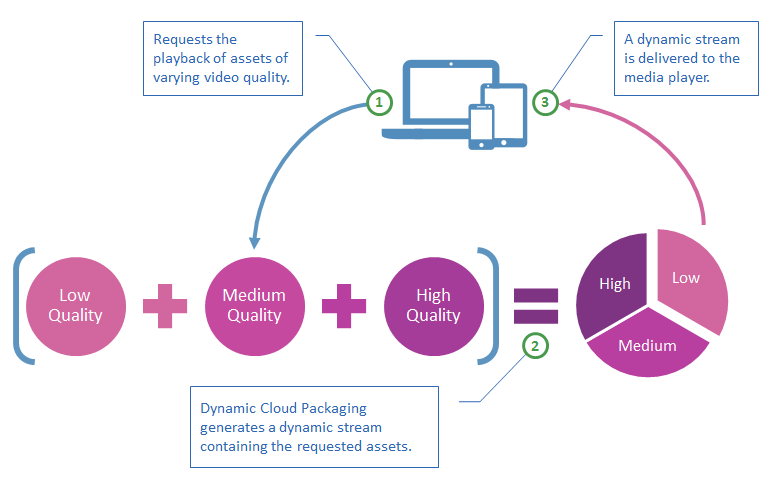Dynamic Cloud Packaging can stream on-demand content to any standard HLS or MPEG-DASH player.
How Does It Work?
Dynamic Cloud Packaging can dynamically repackage one or more assets into a HLS or MPEG-DASH-compatible stream. This process, which is known as transmuxRefers to the process of changing the multimedia container while retaining its content (i.e., audio/video).ing, allows a media player to leverage dynamic streamingAllows a media player to dynamically switch between bit rate streams of varying quality levels, in order to provide an optimal viewing experience based on a client’s bandwidth and CPU usage. on a set of assets as if they had been packaged together.

Delivery
Dynamic Cloud Packaging leverages the HTTP Large platform to stream on-demand content. This allows it to take advantage of our caching technology and our network to efficiently deliver on-demand content from a customer origin or CDN storage.
Learn more about how the HTTP Large platform delivers content.
Workflow
The workflow through which Dynamic Cloud Packaging streams on-demand content is described below.
|
|
Step | Description |
|---|---|---|
|
1 |
Request |
A media player submits a request to stream one or more assets. This request identifies:
|
|
2 |
CDN |
This request is routed to the POPIdentifies a location on our network through which users can request and receive content. closest to the viewer. A check will be performed to see whether the requested content has been previously cached.
|
|
3 |
Dynamic Cloud Packaging |
Dynamic Cloud Packaging will transmuxRefers to the process of changing the multimedia container while retaining its content (i.e., audio/video). the set of assets requested by the media player. This process generates a HLS or MPEG-DASH manifest file that allows the media player to dynamically switch streams based on the viewer's bandwidth and CPU usage. Once this manifest file has been generated, the requested content will be streamed via the HTTP Large platform to the viewer. |
More Information
- Tutorial
- Interaction with the HTTP Large Platform
- Requirements
- Preventing Unauthorized Viewing
- Purging Live and On-Demand Content
Edgecast CDN